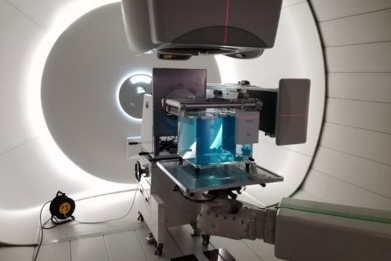Getting to know your Partners

Johannes Petzoldt, a fellow based at Ion Beam Applications, has recently visited the partner organizations that will be closely involved in his project.
 His first secondment was at the University of Pennsylvania. Johannes met the clinical partners, Dr. Teo and Dr. Xie, for the first time and discussed further strategies concerning the prompt gamma camera prototype. The device is used to determine the proton range and the first data acquisition during patient treatment with pencil beam scanning was performed at UPenn in June 2016. As part of the secondment the fellow learned to perform the temperature and energy calibration of the camera – a procedure necessary every couple of months to ensure proper functionality and, consequently, proton range retrieval. Supervised by Dr. Smeets the fellow performed successful calibration measurements, and the knowledge gained was summarized in a step-by-step manual. Additionally, the fellow took the opportunity to get an impression on the local site and the different treatment rooms.
His first secondment was at the University of Pennsylvania. Johannes met the clinical partners, Dr. Teo and Dr. Xie, for the first time and discussed further strategies concerning the prompt gamma camera prototype. The device is used to determine the proton range and the first data acquisition during patient treatment with pencil beam scanning was performed at UPenn in June 2016. As part of the secondment the fellow learned to perform the temperature and energy calibration of the camera – a procedure necessary every couple of months to ensure proper functionality and, consequently, proton range retrieval. Supervised by Dr. Smeets the fellow performed successful calibration measurements, and the knowledge gained was summarized in a step-by-step manual. Additionally, the fellow took the opportunity to get an impression on the local site and the different treatment rooms.
 Johannes also performed an experimental work in the IBA facility in Dresden in collaboration with the clinical partners of OncoRay. One of Johannes’ tasks within the project is to develop a model for a geometrical correction of the prompt gamma camera prototype, which depends on several parameters like camera setup and beam energy. To benchmark the model, experimental data under very specific conditions is required. The experiment was prepared together with the group of Dr. Richter and conducted in the gantry treatment room in a night shift. High positioning accuracy of 0.1mm could be achieved by using the X-ray system of the treatment room. The fellow not only learned how to control the beam and the camera, but also participated in the changing of the ion source of the cyclotron during the night shift.
Johannes also performed an experimental work in the IBA facility in Dresden in collaboration with the clinical partners of OncoRay. One of Johannes’ tasks within the project is to develop a model for a geometrical correction of the prompt gamma camera prototype, which depends on several parameters like camera setup and beam energy. To benchmark the model, experimental data under very specific conditions is required. The experiment was prepared together with the group of Dr. Richter and conducted in the gantry treatment room in a night shift. High positioning accuracy of 0.1mm could be achieved by using the X-ray system of the treatment room. The fellow not only learned how to control the beam and the camera, but also participated in the changing of the ion source of the cyclotron during the night shift.
As a result, the necessary data was obtained in this experiment and will be analyzed back home in Louvain-la-Neuve.
Johannes found both visits very useful for the scientific development of his project, as well as establishing close links with the project partners.